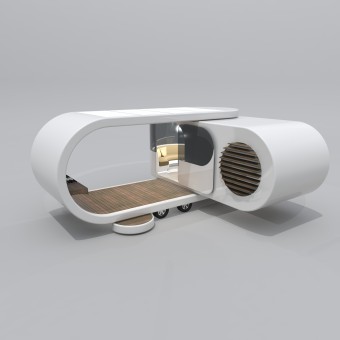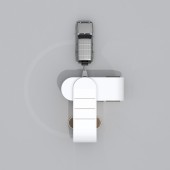Romotow Mobile Home by Stuart Winterbourn & Matt Wilkie |
Home > Winners > #31563 |
 |
|
||||
| DESIGN DETAILS | |||||
| DESIGN NAME: Romotow PRIMARY FUNCTION: Mobile Home INSPIRATION: Mobile living designs are very outdated, they do not address a transition between inside and outside, and have poor indoor-outdoor flow. We live in a beautiful world and the Romotow design maximises the enjoyment of it. UNIQUE PROPERTIES / PROJECT DESCRIPTION: Incorporates patented relative translation of an inner and outer shell to increase floor area by up to 70% into a contemporary style of mobile home. The design provides a generous outdoor space - deck - which no one else in the market can offer. OPERATION / FLOW / INTERACTION: Automated or manual operation. The mobile home opens to reveal a transitional space to the outside, with the option to enclose. PROJECT DURATION AND LOCATION: Romotow was designed in Christchurch, New Zealand the Prototype is now being fabricated in Auckland with a projected finish date of 2014 FITS BEST INTO CATEGORY: Vehicle, Mobility and Transportation Design |
PRODUCTION / REALIZATION TECHNOLOGY: Romotow is fabricated from advanced composite materials and adhesives using a manufacturing process called infusion - a closed molding process which involves injecting resin into the dry fibres and core under vacumn . Panels are made individually and then bonded together in a build jig using polymer adhesives . SPECIFICATIONS / TECHNICAL PROPERTIES: 2500mm x 3140mm x 7800mm TAGS: caravan, mobile home, rv, travel trailer, romotow, recreational vehicle RESEARCH ABSTRACT: - CHALLENGE: There were 3 main challenges when designing the Romotow the first being able to design the accommodation cabin and surrounding "hoop" to support each other when stationary and also whilst being towed long distances. This was achieved thru using a light weight slew ring attached to a hydraulic ram in the main chassis and at the top a molded key way in the cabin roof and the support “hoop” this acts as both a track and locking path to hold each together both at rest and during transit. Another issue is that the cabin cannot rotate without hitting the surrounding hoop at the rear so the cabin at first has to slide forward a certain distance then rotate either clock wise or anti clock wise 90 degrees once it has done this it then continues sliding forward to its fixed position – the reason it does not slide completely forward first and then rotate is that the draw bar would have to be another 1300mm longer than its current design to avoid the cabin hitting the tow vehicle thru the rotation process. Once we had solved these 2 main issues we then had to pay particular attention to the overall weight of the Romotow and also how the changing centre of gravity affects the overall stability of the product thru the rotation process , as the change is so drastic we have designed support arms that fold out after rotation has taken place to both support the cabin and also the chassis. ADDED DATE: 2013-12-05 11:28:38 TEAM MEMBERS (3) : Stuart Winterbourn, Matt Wilkie and W2 Limited IMAGE CREDITS: Stuart Winterbourn & Matt Wilkie, 2013. |
||||
| Visit the following page to learn more: http://www.romotow.com | |||||
| AWARD DETAILS | |
 |
Romotow Mobile Home by Stuart Winterbourn & Matt Wilkie is Winner in Vehicle, Mobility and Transportation Design Category, 2013 - 2014.· Read the interview with designer Stuart Winterbourn & Matt Wilkie for design Romotow here.· Press Members: Login or Register to request an exclusive interview with Stuart Winterbourn & Matt Wilkie. · Click here to register inorder to view the profile and other works by Stuart Winterbourn & Matt Wilkie. |
| SOCIAL |
| + Add to Likes / Favorites | Send to My Email | Comment | Testimonials | View Press-Release | Press Kit |
Did you like Stuart Winterbourn & Matt Wilkie's Vehicle Design?
You will most likely enjoy other award winning vehicle design as well.
Click here to view more Award Winning Vehicle Design.








